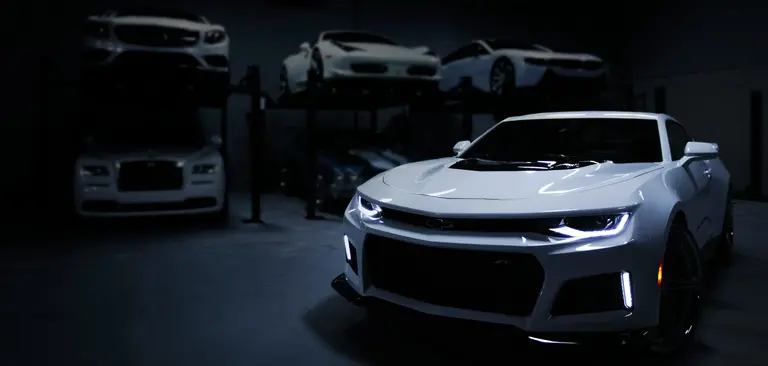Buying a classic vehicle is very exciting, but the older a car gets, the more temperamental it becomes. Knowing how to maintain a classic car properly can be the difference between enjoying your vehicle on a regular basis and having to stress about its reliability.
Whether you’re a DIYer or you’re looking to have the work done for you, this classic car maintenance guide will help you figure out the best ways to keep your car running (and looking) its best.
Drive It
 Driving your classic car is the most fun form of maintenance you can do!
Driving your classic car is the most fun form of maintenance you can do!
Not all classic cars can be daily drivers, the worst thing you can do to an older vehicle is to let it sit. Time and weather permitting, you should try to drive your vehicle at least once a month for about 30 minutes or so - long enough to keep all of the car’s components in good working order. Just starting the vehicle frequently is good enough to help protect the engine and battery, but actually driving the car will ensure the tires don’t get flat spotted, the calipers don’t seize, etc. Before embarking on a drive, get the engine up to operating temperature and do a quick check for leaks.
Proper Storage
If you do need to let the vehicle sit for extended periods of time, there are precautions you can take to protect the car. A battery tender should be the first item anyone should buy when purchasing a classic vehicle, and if you’re storing the vehicle, a car cover is second on the list. Even if you’re parking it inside, having it covered up will protect the finish from dust or being bumped up against. A set of jack stands will help prolong the life of the tires, and a fuel stabilizer will keep the gasoline fresh.
Fluid Changes
Just like a modern vehicle, fluid changes are crucial to proper classic car maintenance. Staying on top of your car’s fluids will help lengthen the life of the engine, transmission, and axles, and it means the car is ready to drive whenever you are. Along with fluid changes, don’t forget to maintain greased components such as wheel bearings, U-joints, ball joints, etc.
Inspect Regularly
You should always have a vehicle inspected before you buy it, but it’s a good idea to inspect the vehicle regularly during your ownership. If it sits a lot, check for any signs of leaks before driving the car, and also be sure to inspect hoses and belts. Even if you don’t live in the Rust Belt, keep an eye out for rust; catching rust early can be the difference between a simple sand-and-repaint job versus replacing sheet metal. Regular inspections don’t take long, and they can save you a lot of money.
Tires
After the main mechanical components such as the engine and transmission, tires might be some of the most expensive parts on any vehicle, so they should be high on your classic car maintenance routine. Rotating the tires is easy to ensure tread wear is even, but you also need to check the tires regularly for proper pressures. Even if the tires have plenty of tread left, they should be replaced if you notice cracking or dry rot.
Use Quality Replacement Parts
If you don’t get anything else from this classic car maintenance guide, using quality parts might be one element of vehicle ownership that some people overlook. The key to getting the best from your classic car maintenance is putting the most into your effort. Even on older vintage cars, you’d be surprised at the variety of parts that are available at your local parts store. If at all possible, try to avoid getting parts from Amazon or eBay, and only resort to junkyard parts if they are OEM and testable (or warrantable).
Regular Detail Work
 Regular detailing protects your car’s paint and interior, and keeps it looking great! | Credit: Brad Starkey via Unsplash
Regular detailing protects your car’s paint and interior, and keeps it looking great! | Credit: Brad Starkey via Unsplash
Keeping your classic car clean is great for showing off, but it also protects the vehicle in the long run. Removing dirt and contaminants will protect the luster of your car’s paint and wheel finish, and a good interior detail limits the chances of stains or damage to interior parts. Just make sure any cleaners you use are suited for automotive purposes.
Find A Good Mechanic
Even if you’re a well-versed DIYer, having contact with a good mechanic can make classic car ownership more enjoyable. If nothing else, such a person or business can help track down hard-to-find parts, but they also have access to tools and equipment that most car owners don’t have, such as a vehicle lift.
Proper Insurance Coverage
Although not directly tied to classic car maintenance, having proper insurance can save you a lot of money, which means you’ll have more for upkeep and repairs. A number of companies write insurance policies specific to classic cars, but you should pay attention to mileage caps and replacement value. In the case of custom cars, insurance companies can offer an Agreed Value in the event the vehicle is damaged or stolen.
Save Money
It’s always a good idea to have a little extra money set aside for car repairs and maintenance, but this is even more helpful on an older classic vehicle that might not get driven on a regular basis. As mentioned above, the longer a car sits, the more problems that are likely to pop up, and the chances for an issue only increase as the vehicle’s age and mileage go up.
